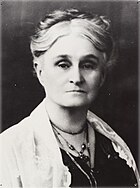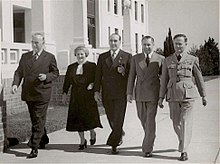Women's suffrage in Australia


Women's suffrage in Australia began to be established during the late 19th century, beginning with South Australia in 1895 and Western Australia in 1899. In 1902, the newly established Australian Parliament passed the Commonwealth Franchise Act 1902, which enabled women to vote and stand for election for the federal Parliament. This eradicated gender as a point of discrimination in relation to electoral rights for federal elections in Australia. By 1911, the remaining states and territories had all granted women's suffrage for state elections.
History
Background
Traditional aboriginal society had been governed by councils of elders and a corporate decision making process, but the first European-style governments established after 1788 were autocratic and run by appointed governors - although English law was transplanted into the Australian colonies by virtue of the doctrine of reception, thus notions of the rights and processes established by the Magna Carta and the Bill of Rights 1689 were brought from Britain by the colonists. Agitation for representative government began soon after the settlement of the colonies.[1]
The oldest legislative body in Australia, the New South Wales Legislative Council, was created in 1825 as an appointed body to advise the Governor of New South Wales. In 1840 the Adelaide City Council and the Sydney City Council were established with limited male suffrage. Australia's first parliamentary elections were conducted for the New South Wales Legislative Council in 1843, again with voting rights (for males only) tied to property ownership or financial capacity. Voter rights were extended further in New South Wales in 1850 and elections for legislative councils were held in the colonies of Victoria, South Australia, and Tasmania.[2]
By the mid-19th century, there was a strong desire for representative and responsible government in the colonies of Australia, fed by the democratic spirit of the goldfields evident at the Eureka Stockade and the ideas of the great reform movements sweeping Europe, the United States and the British Empire. The end of convict transportation accelerated reform in the 1840s and 1850s. The Australian Colonies Government Act, passed in 1850, was a landmark development that granted representative constitutions to New South Wales, Victoria, South Australia and Tasmania and the colonies enthusiastically set about writing constitutions which produced democratically progressive parliaments - though the constitutions generally maintained the role of the colonial upper houses as representative of social and economic "interests" and all established Constitutional Monarchies with the British monarch as the symbolic head of state.[3] 1855 also saw the granting of the right to vote to all male British subjects 21 years or over in South Australia. This right was extended to Victoria in 1857 and New South Wales the following year. The other colonies followed until, in 1896, Tasmania became the last colony to grant universal male suffrage.[2]
Women's suffrage


A movement for Women's suffrage also gathered pace during the 19th century. The female descendants of the Bounty mutineers who lived on Pitcairn Islands could vote from 1838, and this right transferred with their resettlement to Norfolk Island (now an Australian external territory) in 1856.[4] Propertied women in the colony of South Australia were granted the vote in local elections (but not parliamentary elections) in 1861. Henrietta Dugdale formed the first Australian women's suffrage society in Melbourne, Victoria in 1884.
Suffrage petitions
The suffrage societies across the continent collected signatures for monster petitions to be tabled in Parliament. The results varied. Recently some of these petitions have been transcribed and can be searched digitally. The Parliament of South Australia endorsed the right to vote and stand for parliament 1894 and the law received Royal Assent from Queen Victoria in 1895. In 1897 Catherine Helen Spence became the first female political candidate for political office, unsuccessfully standing for election as a delegate to Federal Convention on Australian Federation.[5] Western Australia granted voting rights to women in 1899.[6]
The first election for the Parliament of the newly formed Commonwealth of Australia in 1901 was based on the electoral provisions of the six pre-existing colonies, so that women who had the vote and the right to stand for Parliament at state level had the same rights for the 1901 Australian Federal election. In 1902, the Commonwealth Parliament passed the Commonwealth Franchise Act, which enabled women to vote and stand for election for the Federal Parliament. Four women stood for election in 1903.[6] The Act did, however, specifically exclude 'natives' from Commonwealth franchise unless already enrolled in a state. In 1949, the right to vote in federal elections was extended to all Indigenous people who had served in the armed forces, or were enrolled to vote in state elections (Queensland, Western Australian, and the Northern Territory still excluded Indigenous women from voting rights). Remaining restrictions were abolished in 1962 by the Commonwealth Electoral Act.[7]
Edith Cowan was elected to the Western Australian Legislative Assembly in 1921, the first woman elected to any Australian Parliament. Dame Enid Lyons, in the Australian House of Representatives and Senator Dorothy Tangney became the first women in the Federal Parliament in 1943. Lyons went on to be the first woman to hold a Cabinet post in the 1949 ministry of Robert Menzies.
Rosemary Follett of the Australian Labor Party was elected Chief Minister of the Australian Capital Territory in 1989, becoming the first woman elected to lead a state or territory. The state parliamentary Labor Parties of Western Australia and Victoria selected women to replace their incumbent leaders in 1990 - thus in Western Australia, Carmen Lawrence became the first female premier of a state and Joan Kirner became Premier of Victoria. Both leaders suffered defeat at the subsequent state elections. The Australian Capital Territory elected the Liberals' Kate Carnell during the mid-1990s, but it was not until 2009 that a woman leader led an Australian political party to victory in a state election when Anna Bligh won the Queensland State Election.[8]
In 2010 Sydney, Australia's oldest city, had female leaders occupying every major political office, with Clover Moore as Lord Mayor, Kristina Keneally as Premier of New South Wales, Marie Bashir as Governor of New South Wales, Julia Gillard as Prime Minister, Quentin Bryce as Governor-General of Australia, and Elizabeth II as Queen of Australia.
See also
- History of Australia
- Human rights in Australia
- Politics of Australia
- Suffrage in Australia
- Women and government in Australia
- List of suffragists and suffragettes
- List of women's rights activists
- Timeline of women's suffrage
- Utopia Girls - How Women won the Vote. Website for ABC TV production about women's suffrage
References
- ^ "Our Democracy: Democracy timeline — Museum of Australian Democracy at Old Parliament House". Moadoph.gov.au. Retrieved 2011-04-19.
- ^ a b "Australia's major electoral developments Timeline: 1788 - 1899 - Australian Electoral Commission". Aec.gov.au. 2010-06-11. Retrieved 2011-04-19.
- ^ "The Right to Vote in Australia - Australian Electoral Commission". Aec.gov.au. 2007-11-26. Retrieved 2011-04-19.
- ^ EC (2005-04-13). "Votes for Women | Elections New Zealand". Elections.org.nz. Retrieved 2011-04-19.
- ^ "Documenting Democracy". Foundingdocs.gov.au. Retrieved 2011-04-19.
- ^ a b "Electoral Milestones for Women - Australian Electoral Commission". Aec.gov.au. 2008-12-17. Retrieved 2011-04-19.
- ^ "AEC.gov.au". AEC.gov.au. Retrieved 2011-01-08.
- ^ "Beaming Bligh: You can count on me - ABC News (Australian Broadcasting Corporation)". Abc.net.au. Retrieved 2011-04-19.
